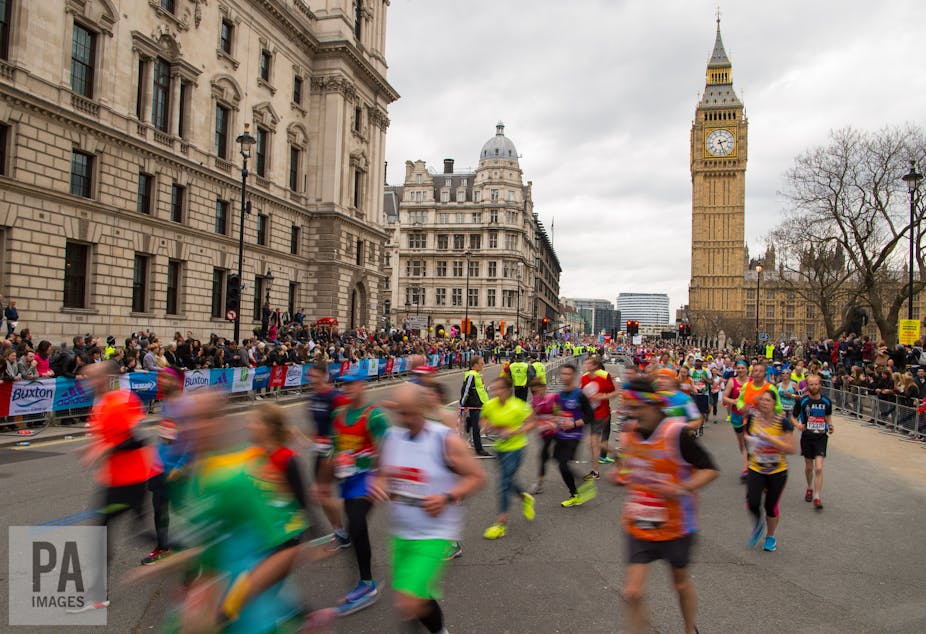It is one of the world’s most famous races. On April 23, 2017, as many as 40,000 people will head to Blackheath in south-east London. From there, they will run (or jog, or walk, or wheel) the 26.2 mile distance of the London Marathon. Most will arrive some hours later at the finishing line after completing an athletic challenge that captures the imagination of television viewers globally.
This will be the 37th time the event has taken place. To launch its 1981 debut, founders and former Olympians Chris Brasher and John Disley took a significant personal financial risk, with the support of a single title sponsor. Modelled on the already well-established New York Marathon, it was a watershed moment for British marathon running.
A total of 6,255 runners completed that first race, which was broadcast live on television. This exposure contributed to a huge growth in demand for places, and just over 18,000 runners (from an entry ballot of 90,000 applicants) lined up the following year.
For some, the London Marathon triggered a boom in the popularity of endurance running. As a result of its continued growth, more and more people now take part in running, benefiting from its associated effects on health and well-being. But as the popularity of the event has grown, so too has the London Marathon’s attraction as a fundraising phenomenon.
It holds the Guinness world record for the largest annual fundraising event globally, and three out of four participants this year will be running for a good cause. One in three starting places is offered to people via a charity. These starting places are secured exclusively by charitable organisations, who are then free to offer the places to people in exchange for a guaranteed minimum level of personal fundraising.
But fundraising is not the only financial element of the modern London Marathon. Every entrant is also required to attend a registration and exhibition event that includes lucrative marketing opportunities for major sportswear labels and other brands.
And herein lies the difficulty. The marathon represents an athletic challenge which Brasher and Disley created to provide runners with an opportunity to test themselves in a capital city. But for many, the biggest challenge lies not in running 26 and a bit miles – but in actually getting the chance to take part.
The popularity of the event immediately led to over-subscription for places – three times as many applicants than places in 1981; five times as many a year later.
In the current ballot system of participation, the probability of success fell from around 14% in 2014, to 6.9% in 2016. This inevitably pushes around 220,000 rejected applicants towards the already secured “charity-owned” places. The UK’s governing body for athletics also recently halved the number of guaranteed places affiliated running clubs could offer to members.

So for an aspiring habitual runner, for whom the marathon represents an athletic pursuit in its purest sense – the vision set out by Brasher in a 1979 article in The Observer – the likelihood of making it to the start line in Blackheath is relatively limited. For the willing charity runner, with fundraising as their main goal, the odds are significantly better.
As the popularity and profile of the London Marathon have grown, the aims and ambitions of the event’s organisers have subtly changed. The number of dedicated runners following in the footsteps of pioneers Brasher and Disley has diminished. And if you’re inspired to take part in the future after watching the beautiful backdrops and inspiring support of Sunday’s race, you’re much more likely to be at the start line in 2018 if you show a commitment to fundraising, than through dedication to endurance running.
Not a sprint
Of course, there are other options for marathon runners. The growth in running events since 1981 has gone some way meet demand. The UK calendar of marathons provides opportunities to run the distance on most weekends during the spring and summer, and many of these races do not require a ballot entry system.

But as we immerse ourselves in the excitement of the London Marathon, spare a thought for the many lifelong endurance runners and dedicated athletic club members who will be following the day as spectators rather than as participants.
Perhaps it will take creative and dynamic thinking similar to that of Chris Brasher and John Disley to reimagine a big city running event which promotes athletic pursuit for its own sake and encourages physical activity. Then we could go back to having a race in which sporting endeavour takes first place.

